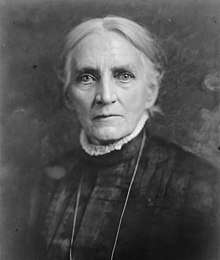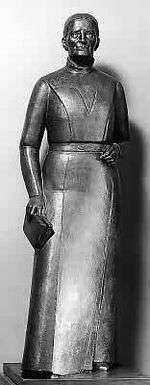Maria Sanford
Maria Louise Sanford (December 19, 1836 – April 21, 1920) was an American educator.

Biography

(NSHC statue)
Maria Sanford was born in Saybrook, Connecticut. Her love for education began early; at the age of 16 she was already teaching in county day schools. She graduated with honors from State Normal School (now Central Connecticut State University), using her dowry funds for tuition. She rose in the ranks of local and national educators, becoming principal and superintendent of schools in Chester County, Pennsylvania. She took the place of Anna Hallowell and served as professor of history at Swarthmore College from 1871 to 1880. She was one of the first women named to a college professorship. Dr. William Watts Folwell, President of the University of Minnesota at the time, invited Sanford to join the faculty.[1] She did so enthusiastically. Dr. Folwell declared that hiring Sanford was one of his proudest achievements.
During her tenure at the university (1880–1909) Sanford was a professor of rhetoric and elocution, and she lectured on literature and art history. Sanford made strong connections with her students and challenged them with surprise tests and poetry recitations. She held student social events in her home and gave speeches to organizations and groups across the nation. She was a champion of women's rights, supported the education of blacks, pioneered the concept of adult education, and became a founder of parent-teacher organizations. Notably, however, she resisted universal suffrage until her late seventies. Sanford was also a leader in the conservation and beautification program of her new state. She retired in 1909. However, that did not stop Sanford from reaching out to the community and nation with the power of her speeches. She traveled throughout the United States delivering more than 1000 patriotic speeches, the most famous being the powerful address An Apostrophe to the Flag, that she delivered at a national Daughters of the American Revolution convention. Sanford became head director for Northwestern Hospital and created the Minneapolis Improvement League. She was also picked in 1920 to give a speech at the state celebration of the passing of the 19th amendment.
In 1910, the University of Minnesota constructed Sanford Hall in honor of Sanford. In 1964 they expanded the building by adding on a "Tower" to house more students. It was originally built to house the women of the campus. In the 1970s, the hall became coeducational, and housed 502 residents.[2]
She died on April 21, 1920, at the age of 83. In June of that year the University of Minnesota held a memorial convocation in her honor. Her death made the cover of the Minneapolis Tribune. A school in Minneapolis, Minnesota, was named Maria Sanford Junior High (now called Sanford Middle School) in memory of her. An elementary school in Montevideo, Minnesota, too, was named Maria L. Sanford Elementary School. She was called "the best loved woman of the North Star State."[3] Additionally, an academic hall, Maria Sanford Hall, at Central Connecticut State University is named after her.
In 1958, Minnesota picked Sanford to represent the state in Statuary Hall.[4].
Death
Sanford died on April 21, 1920 in Washington, D.C. and is interred at Mount Vernon Cemetery in Philadelphia, Pennsylvania.[5]
Legacy
Sanford was the namesake of a World War II Liberty ship, the SS Maria Sanford, launched in 1943. In 1958, the state of Minnesota donated a bronze statue of Sanford, created by Evelyn Raymond,[6] to the U.S. Capitol's National Statuary Hall Collection.
References
- "U of M English prof Maria Sanford was one of first female professors in U.S." MinnPost. 19 March 2013.
- "University of Minnesota Housing & Residential Life".
- "Maria Sanford". aoc.gov. Retrieved 5 November 2015.
- "National Statuary Hall Collection"
- "Maria Louise Sanford". www.findagrave.com. Retrieved 7 September 2019.
- "Maria Sanford". Retrieved 17 February 2017.
External links
![]()
- Architect of the Capitol at www.aoc.gov